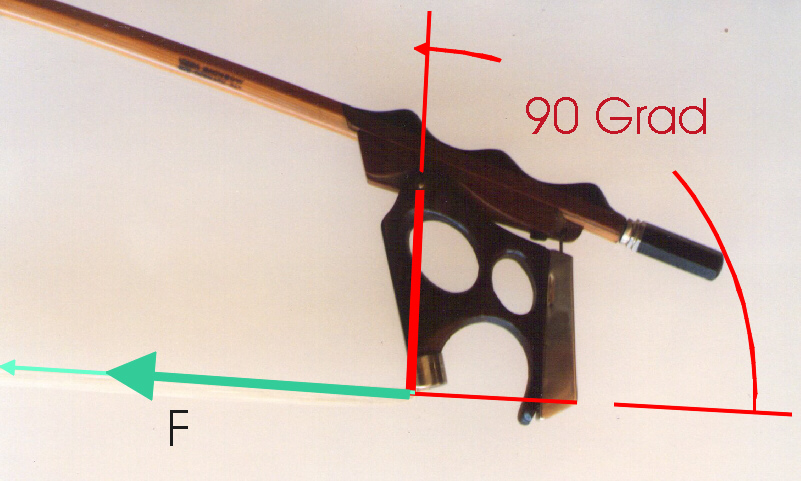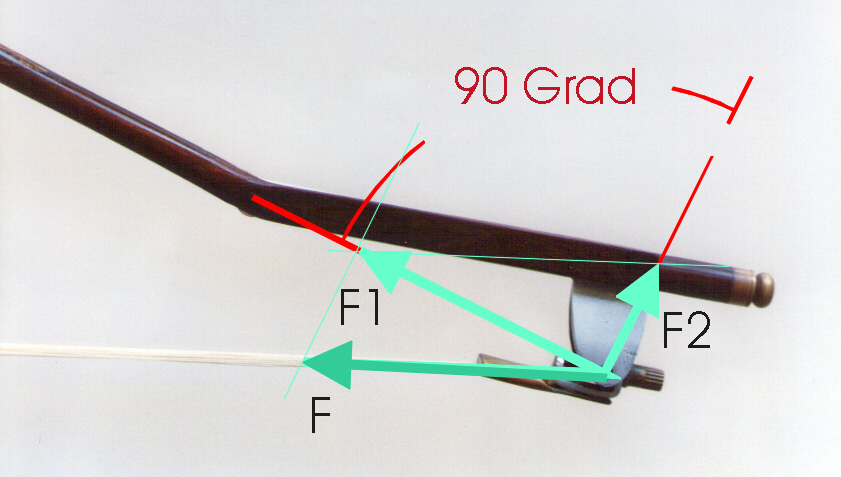December 23, 1906 – July 20, 1998
His playing with the curved bow. His Bach interpretation.
Tossy Spivakovsky’s article on the solo works for violin by J. S. Bach 1) from 1967 became known to me through Rudolf Gaehler’s book, The Curved Bow for the Violin – a Phantom? 2) and also by the fact that Spivakovsky used a curved bow, the VEGA BACH BOW made by the Danish violin maker Knud Vestergaard, which was originally designed for the violinist Emil Telmányi (1892 – 1988). I found it regrettable, however, that until now not a single recording of Spivakovsky performing with his curved bow was available. More or less coincidentally, I managed to contact the photographer Ruth Voorhis, the daughter of Spivakovsky, and received some photographs of his VEGA BACH BOW. She told me that a live recording of the Chaconne, played by Spivakovsky with the curved bow, had just been released 3).
Since the beginning of the nineties I was well acquainted with this VEGA BACH BOW (Fig. 1) because Rudolf Gaehler has a copy of it in his collection. A detailed documentation of this curved bow is available on the Hungarian website https://www.vonokeszites.hu/en/bows/emil-telmanyi.
It is striking to me that Spivakovky’s curved bow shows very strong traces of use, showing me the undoubtedly considerable significance this curved bow had for him. Heroic battles must have taken place in the control of this bow tool. Secondly, Spivakovsky had removed the locking mechanism intended to relieve the thumb 4), since otherwise it would have had to withstand the high pulling power of its hair during single-voice playing. This elimination of the snap-in locking function is a clear indication to me that Spivakovsky found out that such mechanisms, in order to relieve the muscles, are complicated to handle, are ultimately more of a technical barrier and therefore counterproductive. Any additional equipment that hinders the immediacy of the playing process minimizes one’s control over the sensitive haptic movements. I myself recognize in such an auxiliary mechanism an indication of a construction that was not fully developed and see myself confirmed by Spivakovsky in the fact that mechanical aids should be scrupulously examined for their expediency and have to prove themselves through experience.
This adverse physical exertion of force required by the VEGA BACH BOW is due to the fact that the lever is relatively short (Fig.2), and its position, when the bow hairs are tightened, shows an angle of about 90 degrees to the hairs. Both of these geometrical characteristics, which physically put too much strain on the violinist’s right hand, are actually insurmountable obstacles. The hollows on top of the grip provide an additional way to hold the right hand in place despite the use of extreme force. In order to reduce the problems for the right hand, however, the designer of a curved bow should seek a solution to the cause of the problem, not just its symptoms. The frog of the VEGA BACH BOW has yet another opening for the thumb, facilitating single-voice playing in the locked position of the frog. The thumb thus alternates between two positions while the bow is in use, and this presents a further complication. In addition to the unfavorable properties of the handle, the bow stick maintains a high curvature in the upper half, i. e. from the middle to the bow tip. Thus, four-part chords over the entire length of the curved bow are playable, but the center of gravity is correspondingly high, complicating single-voice playing further.
Fewer constructional disadvantages hamper the competing model of the curved bow (Fig. 3) invented by Rolph Schroeder (1900 – 1980), since the lever for tightening and relaxing the hairs is longer. According to the principle of the lever, this reduces the force but the distances covered by the thumb are bigger. But this is not a real drawback, as playing reveals. Secondly, in the tightened position the lever is folded into the handle, so the pivot of the lever absorbs a proportion (F1) of the tensile force (F) while one string is being played (Fig. 4). Unfortunately, Telmányi, to whom the curved bow by Schroeder had been demonstrated in the 1930s, was unable to buy the prototype by Schroeder. He had to rely on an independent, newly-designed construction. Spivakovsky, on the other hand, knew only Telmányi’s curved bow and had almost no choice but to operate with a similar bow. It was probably easier and faster for him to acquire a VEGA BACH BOW from Vestergaard in 1957 than to attempt to design on his own a curved bow with uncertain results.
I remember when in 1990 Rudolf Gaehler first let me listen to the recordings of the curved bow performances by Rolph Schroeder, Emil Telmányi and Otto Buechner (1924 – 2008), how fascinated I was just to hear the multi-toned sounds on the violin. However, Telmányi’s difficulties in mastering this very extremely shaped VEGA BACH BOW are clearly audible in his Bach recording from 1954. Therefore I was very excited about the re-release of the Swedish Radio’s 1969 recording of Tossy Spivakovsky’s Chaconne interpretation. Hearing it was a complete surprise, because such an audio document would make one think that Spivakovsky must have had a different curved bow model at his disposal. Almost none of the enormous technical problems this VEGA BACH BOW presents are noticeable in his performance. To take Spivakovsky’s achievement just for granted is inconceivable for me. Spivakovsky’s listeners must have literally fallen off their chairs over such a masterful performance of the Chaconne with the curved bow.
Michael Bach
1) Tossy Spivakovsky, Polyphony in Bach’s Works for Solo Violin, published in 1967 in The Music Review, Vol. 28, No. 4
2) Rudolf Gaehler, Der Rundbogen für die Violine – ein Phantom?, Conbrio Verlag, Regensburg 1997
3) Live Broadcast, Swedish Radio, Stockholm, January 26, 1969, DOREMI DHR-8025-8
4) see photo: Tossy Spivakovsky, Introduction to the Curved Bow for playing Bach’s violin solo works




